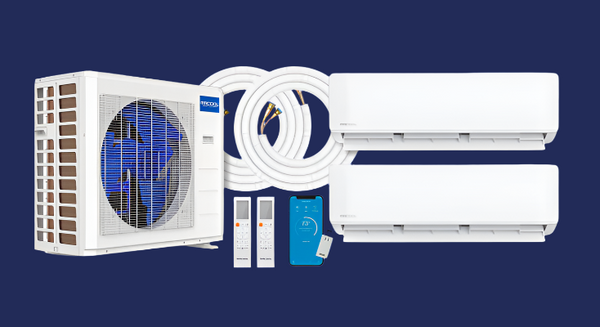MRCOOL DIY Mini-Split Installation: Essential Tips for a Smooth & Efficient Setup
Installing a MRCOOL DIY Mini-Split system is a cost-effective way to upgrade your home’s heating and cooling. With the right approach, you can ensure a hassle-free installation that maximizes efficiency and system longevity. Follow these 15 expert installation tips to set up your MRCOOL Mini-Split for long-term success.
1. Read the Installation Manual Thoroughly
📖 Before starting, carefully read the installation manual that comes with your MRCOOL DIY Mini-Split. This guide provides step-by-step instructions, safety guidelines, and system specifications to help you avoid mistakes during installation.
✅ Pro Tip: Even if you have prior HVAC experience, every mini-split model has unique installation steps, so don’t skip the manual!
2. Choose the Right Installation Location
Selecting the optimal indoor and outdoor unit locations ensures efficient operation and durability.
🏠 Indoor Unit Placement:
✔️ Install on a level surface for proper airflow.
✔️ Keep away from direct sunlight, heat sources, or vents.
✔️ Allow adequate space around the unit for airflow and maintenance.
🌳 Outdoor Unit Placement:
✔️ Position in an open area with proper ventilation.
✔️ Avoid blocking the airflow with bushes, fences, or walls.
✔️ Protect from direct exposure to extreme weather if possible.
✅ Pro Tip: Ensuring both units have proper clearance prevents performance issues and unnecessary strain on the system.
3. Size the System Correctly
📏 Selecting the right-sized MRCOOL Mini-Split for your space is crucial for efficiency.
- Undersized Unit: Will struggle to maintain temperature, causing continuous operation and higher energy costs.
- Oversized Unit: Will cycle on and off too frequently, leading to inefficient operation and unnecessary wear.
✅ Pro Tip: Use a BTU calculator or consult an expert to determine the correct system size based on your home’s square footage.
4. Plan the Piping Route for Maximum Efficiency
📍 Before installation, map out the route for your refrigerant lines, power cables, and condensate drain.
✔️ Avoid sharp bends or kinks in the refrigerant lines.
✔️ Maintain the recommended distance between the indoor and outdoor units.
✔️ Keep pipes insulated to prevent energy loss and condensation buildup.
✅ Pro Tip: Running line sets along exterior walls helps maintain a clean and professional look.
5. Check Electrical Requirements
⚡ Before wiring the system, verify that your home’s electrical system meets MRCOOL’s voltage and amperage specifications.
✔️ Use a dedicated circuit for your mini-split.
✔️ Ensure the breaker and wiring match the system’s required amperage.
✔️ If unsure, hire a licensed electrician for proper electrical setup.
✅ Pro Tip: Using incorrect wiring can void the warranty and pose a fire hazard, so double-check all electrical connections.
6. Keep Line Set Connections Clean & Protected
🛠️ During installation, keep the protective caps on your line sets until you’re ready to connect them.
✔️ Prevents dirt, dust, and moisture contamination.
✔️ Ensures airtight connections, reducing the risk of refrigerant leaks.
✅ Pro Tip: Always hand-tighten fittings first, then use a torque wrench to secure connections to manufacturer specifications.
7. Perform a Leak Test Before Finalizing Installation
🛠️ Once the refrigerant is released, test for leaks to ensure the system is properly sealed.
✔️ Check all fittings and connections using soapy water or an electronic leak detector.
✔️ Snug down loose fittings to prevent refrigerant loss.
✅ Pro Tip: Skipping this step could lead to refrigerant leaks, reducing efficiency and damaging system components.
8. Follow the Wiring & Control Setup Instructions
🔌 Properly wiring your MRCOOL DIY Mini-Split ensures safe operation and system efficiency.
✔️ Follow the included wiring diagram precisely.
✔️ Ensure grounding connections are secure.
✔️ Program control settings for optimal performance.
✅ Pro Tip: Secure wiring away from sharp edges to prevent wear over time.
9. Install the Wall Sleeve Properly
If the indoor unit is mounted through an exterior wall, use a properly sealed and insulated wall sleeve to:
✔️ Prevent air leaks, which reduce system efficiency.
✔️ Protect refrigerant lines from external elements.
✅ Pro Tip: Apply weatherproof sealant around the sleeve to prevent drafts.
10. Ensure Correct Condensate Drain Installation
💧 The condensate drain line must be installed at a downward slope to ensure proper drainage.
✔️ Prevents water backup and leaks.
✔️ Reduces the risk of mold and mildew growth.
✔️ Use a drain trap to block unwanted odors from entering your home.
✅ Pro Tip: Test drainage by pouring water into the indoor unit’s drip tray to confirm proper flow.
11. Secure Units with Sturdy Mounting Brackets
📌 Use durable mounting brackets to support both the indoor and outdoor units.
✔️ Ensure level installation to prevent vibrations.
✔️ Choose brackets rated for the system’s weight.
✔️ Avoid wall materials that cannot support the unit.
✅ Pro Tip: Vibration isolation pads can help reduce operational noise.
12. Test the System in Both Heating & Cooling Modes
🛠️ After installation, run the system through all modes to ensure it operates correctly.
✔️ Check for proper airflow and temperature consistency.
✔️ Listen for unusual noises, rattling, or vibrations.
✔️ Confirm smart thermostat and remote functionality.
✅ Pro Tip: If the system doesn’t perform as expected, double-check connections and settings.
13. Set Up a Routine Maintenance Plan
✅ Regular maintenance helps your mini-split last longer and operate efficiently.
✔️ Clean air filters monthly.
✔️ Inspect refrigerant levels annually.
✔️ Check for dust buildup on indoor and outdoor units.
✅ Pro Tip: Schedule seasonal checkups to keep your MRCOOL system in peak condition.
14. Prioritize Safety During Installation
🛡️ Always use proper safety precautions when handling refrigerants and electrical components.
✔️ Wear safety gloves and goggles.
✔️ Work with a partner for heavy lifting.
✔️ Use a sturdy ladder when installing the indoor unit.
✅ Pro Tip: Never release refrigerant into the air—it’s illegal and harmful to the environment.
15. Seek Professional Assistance If Needed
📞 If you encounter challenges during installation, don’t hesitate to contact a professional HVAC technician.
✔️ Ensures correct setup and warranty protection.
✔️ Helps avoid costly mistakes or system damage.
✔️ Provides expert troubleshooting and guidance.
✅ Pro Tip: MRCOOL DIY Direct offers customer support to assist with any installation questions.
Final Thoughts: Get the Most Out of Your MRCOOL DIY Mini-Split
By following these essential installation tips, you’ll ensure a smooth setup, improved system efficiency, and long-term performance.
🌡️ Experience hassle-free heating and cooling with MRCOOL DIY Mini-Splits!
🚀 Shop now at www.mrcooldiydirect.com and enjoy energy-efficient comfort!




